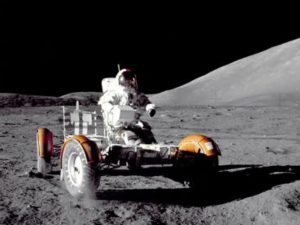For those of you who are unable to spend half their lives in the blogosphere (or on Twitter), you might have come across the frenzied response to NASA’s acting administrator’s suggestion that the US should skip a lunar base and instead focus on the red planet and a few space rocks dancing around Sun.
While I am all for imprinting human footprints, holes, and tire marks in other worlds (and dwarf worlds–sorry Pluto), simply bypassing a permanent residence on Luna for Martian glory is the fastest way to kill America’s future in space, if not set us back a few more decades.
For those of you wondering why a moon base matters, here are five (5) reasons why NASA needs a lunar settlement on Earth’s nearest neighbor.
Its the gravity, stupid!
If humans are ever going to settle the heavenly worlds that dot our sky, then we need to find out whether our bodies are suitable to survive long term off world. Since there are currently 83 terrestrial worlds with gravity ranging from 1/2% to 91% Earth norm, finding the bare minimum will be critical, as it will determine which worlds humanity can raise families upon.
Since the Moon’s gravity is approximately 16.6% Earth norm, it is a perfect candidate for seeing how well our carbon vessels handle a lighter pull from below. Since many of the larger moon worlds (like Ganymede, Callisto and Titan) have similar gravitational strengths, our fair lady Luna may enlighten us as to whether humans will settle beyond the inner belt, or simply upon two worlds (the latter being Mars).
Gravity Well Hell
Lets face it, space is expensive. Unless someone can find a way to build a space elevator (or even a Skyhook), launching anything “into the black” is probably going to be somewhat pricey, regardless of which planet, moon or dwarf planet you choose.
Although worlds like Mars and Mercury have a stronger gravitational pull (both a little south of 38% Earth norm), they also have deeper gravity wells, making fiery exits a bit more expensive.
Worse, NASA still has yet to figure out a way to land large payloads upon Mars, which is not good coming from an agency with the best record for red planet encounters.
Even though the Moon and Mars have different environments (the glorious vacuum verses the 1% atmosphere) it may be wise to heavily test our landing capabilities on Luna (perhaps even “overloading” a lunar lander to help simulate a Martian landing).
Drill, Baby Drill!
Unfortunately for our species, most worlds in our star system are not blessed with a decent atmosphere, which means drilling through dust, rock and metal is not going to be fun, especially when those regolith fragments fuse to your drill bit).
Finding out how to do this effectively will be critical if we are to ever mine the asteroid belt–not to mention settle upon the various moons within our star system. Learning this lunar lesson could prove to be invaluable later on, and could equip our rowdy species with the knowledge to harvest the solar system, (instead of merely dwelling upon worlds for the view).
Dude, where’s my spleen?
Although the above sub title may sound like a sick statement (no pun intended), the fact of the matter is that medical emergencies will probably arise off world–even if ones sole purpose is to merely visit (and not inhabit).
With the Moon being only three (3) days journey away via rocket ride, it is far enough away to test a space facility’s independence–yet close enough just in case we need to intervene in an emergency beyond a space base’s expertise.
Perfecting this will be critical if humanity is to establish outposts elsewhere, as the last thing NASA (or any space agency) needs is dead bodies accumulating due to the lack of treatable wounds, diseases or outbreaks.
Seeing is believing
Space, like all things glamorous will tend to fade from public glory as humanity begins to travel deeper “into the black.” Unless NASA desires to repeat the effects of Apollo, they will need to find some way of keeping our emotions focused on the stars outside of a tragedy.
While rovers driving upon extraterrestrial soil will spark some interest into space exploration, the public at large will probably ignore such accomplishments due to the fact that its made of silicon instead of flesh and blood.
Although seeing a human visit the Moon would accomplish the same result as an off world rover, observing someone live upon the Moon could help spark more people to realize that their destinies belong to the stars.
A long term settlement could also serve as a counterweight, making it much more difficult to abandon the final frontier in the face of future recessions or tragedies beyond Earth’s orbit.
Conclusion
While the Moon is a critical first step for NASA–or any aspiring space power–it should not be the last in our attempts to embrace the heavens above us.
Even though the Moon will not be the perfect beta test for every world that is graced by Sol star’s rays, establishing a presence there will help us settle else where, as well as increase our chances of avoiding asteroid doom (or the various other ways of mass extermination of humanity).
Hopefully President Obama, as well as the new NASA administrator realizes this, as the last thing we need is another space race where the US is playing catch up to a (semi-hostile) rival.

